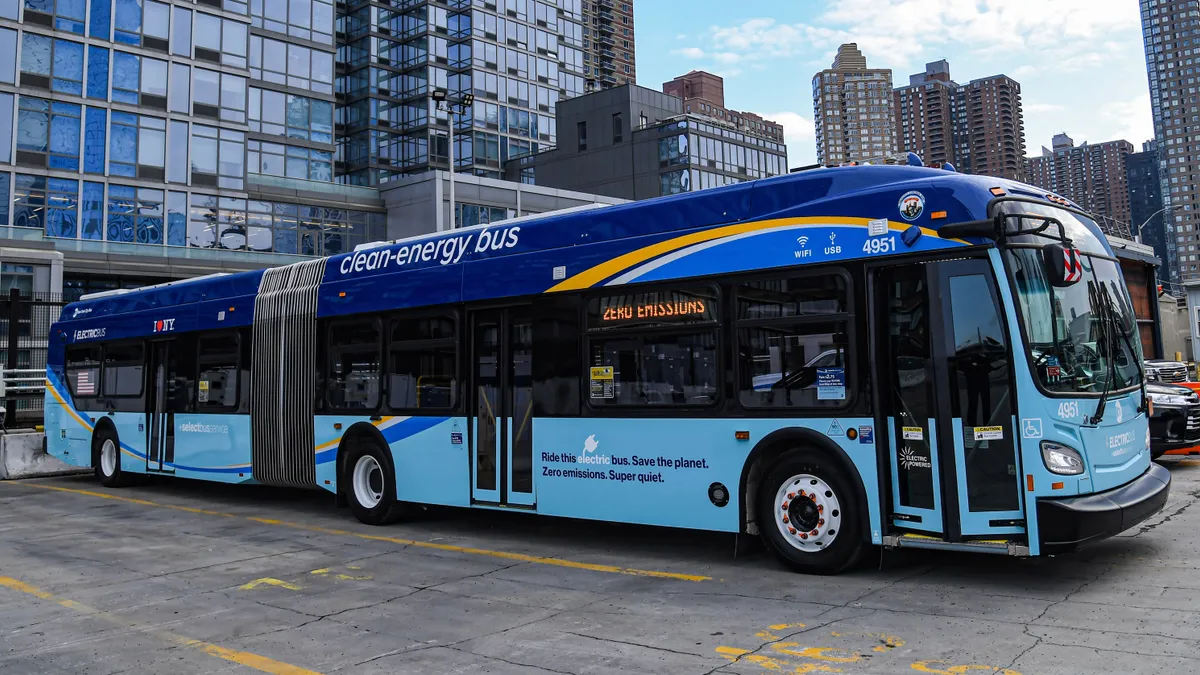Dive Brief:
-
The New York Metropolitan Transit Authority (MTA), which oversees the country's largest public bus system, deployed its first all-electric articulated bus as part of the agency's plan to have a zero-emission fleet by 2040.
-
The MTA intends to spend $1.1 billion to purchase and deploy a fleet of 500 electric buses throughout the city's five boroughs as part of its 2020-2024 Capital Plan to speed up the transition to zero-emission electric vehicles (EVs).
-
Ten electric standard buses currently operate in the city as a part of a 3-year pilot program to test the vehicles' technology and durability. The MTA approved the purchase of 15 all-electric articulated buses to be deployed by March 2020, in addition to 16 in-depot chargers and a mobile charging unit.
Dive Insight:
The MTA's investment is the latest way New York City is taking the lead against climate change. The city’s climate goals include a Green New Deal commitment to achieve carbon neutrality by 2050 and 100% use of clean electricity. New York has also taken the reigns with progressive congestion pricing plans and a Climate Mobilization Act, which could be considered the most ambitious city-level work against climate change yet.
The MTA's $1.1 billion investment appears to be equally ambitious.
"As the largest transit agency in the United States, New York is a natural leader in this effort and cities all across America are watching New York’s leadership in this regard," he said. "I think New York has very accurately identified electric buses as one of the best and quickest ways to significantly eliminate carbon emissions from our cities and it's an obvious choice for elected officials to commit to in order to improve the sustainability of their cities."
However, bus trips represent only 8% of travel in New York City, according to a 2018 NYC Department of Transportation report. The MTA's investment is a first step and "the pathway we need to be focused on going down," but it's also not the ultimate goal, Bloomberg Associates' Principal Adam Freed told Smart Cities Dive.
Buses are at the front end of vehicle electrification globally and are moving at a much quicker pace than passenger vehicles or trucks, and that's projected to continue, he said. So while electric buses might not carry climate goals across the finish line, they do have important benefits and are widely being adopted across cities. It's "absolutely a smart investment," Freed said.
California has also set its own ambitious target to have 100% zero emission bus fleets by 2040, which is expected to reduce 19 million metric tons of greenhouse gas (GHG) by 2050, or the the removal of 4 million cars off the state's streets. And China remains the global leader in electric bus fleets with the country expected to have 600,000 electric buses by 2025 compared to the U.S.' almost 5,000.
Transportation is the second largest GHG emitter in New York, accounting for 30% of emissions (buildings are responsible for the largest GHG contribution at 67%). Currently, the MTA eliminates 17 million metric tons of carbon emissions each year by providing public transit services instead of personal vehicle use, according to the agency.
City buses are some of the first instances where people can see, feel and understand the impact that EVs hold for a community, Freed said. Some of those additional effects outside of GHG reduction include noise pollution and air quality improvements.
Other plans to improve the bus efficiencies in New York include redesigning the bus route network in each of the five boroughs; automating bus lane enforcement; and working with the New York Police Department to enforce proper bus lane usage, according to the MTA's official statement.
NYC Transit currently has a request for proposals out for an order of 45 standard electric buses that will be used in each borough starting April 2021 through the end of 2021.
















